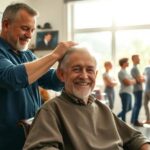Laser treatment for hair loss: does it work?
Hair loss can be a distressing experience for many people, whether due to genetic factors, stress, or other underlying health issues. As more individuals search for effective solutions, laser treatment has emerged as a popular option. But does it actually work? In this article, we will explore the efficacy of laser treatments, particularly focusing on low-level laser therapy (LLLT) for hair regrowth.
Understanding how these treatments function and their potential benefits can help you make an informed decision if you’re considering options to combat hair loss.
What is low-level laser therapy for hair loss?
Low-level laser therapy (LLLT) is a non-invasive method that utilizes specific wavelengths of light to stimulate hair follicles, promoting hair regrowth. This technique is primarily applied to individuals suffering from androgenetic alopecia, a common form of hair loss.
LLLT works by increasing blood flow and enhancing cellular metabolism in the scalp, which can lead to healthier hair follicles and potentially increased hair density. The method is safe and has minimal side effects, making it a viable option for many.
Devices used for LLLT include helmets, caps, and handheld combs that emit the therapeutic light. Users can conveniently apply these devices at home, adding to the treatment's appeal.

Can cold laser therapy regrow hair?
One of the most frequently asked questions is, can cold laser therapy regrow hair? The evidence suggests that LLLT can indeed stimulate hair regrowth in many individuals, particularly in the early stages of hair loss.
Clinical studies have demonstrated that patients using LLLT devices showed significant improvements in hair density and thickness after consistent use. While results can vary based on individual factors, it is generally accepted that cold laser therapy can promote hair regrowth effectively.
You may be interested in reading: Is male-pattern baldness treatable after 60?
Is male-pattern baldness treatable after 60?Moreover, it is not only suitable for men; women have also reported positive results from low-level laser therapy, making it a flexible option for different demographics.
What are the benefits of low-level laser therapy?
- Non-invasive approach: LLLT does not require surgical intervention, making it a less intimidating option for many.
- Minimal side effects: Most users experience few, if any, side effects, which is a significant advantage over more invasive procedures.
- Convenience: With devices available for home use, patients can easily integrate treatment into their daily routines.
- Safety: LLLT is recognized as safe for various hair types, making it accessible to a broader audience.
In addition to these benefits, it is essential to consider the long-term commitment involved in LLLT. Regular use over several months is often necessary to achieve visible results.
How does low-level laser therapy work?
The science behind LLLT is rooted in photobiomodulation. This process involves the absorption of light by cellular components, leading to improved cell function and health. When applied to the scalp, the red light penetrates the skin and stimulates the hair follicles.

A crucial aspect of this therapy is its ability to activate epidermal stem cells in the scalp. These cells are integral to hair follicle regeneration, and their activation can result in increased hair growth.
Additionally, LLLT enhances blood circulation, which provides essential nutrients and oxygen to hair follicles, further supporting their health and function.
Are there any side effects of low-level laser therapy?
Generally, low-level laser therapy is considered safe, with very few reported side effects. Most users experience temporary effects, such as mild scalp irritation or redness, which usually resolve quickly.
It is essential, however, to consult with a healthcare professional before starting any new treatment, especially if there are underlying health concerns. This is particularly crucial for those experiencing rapid hair loss, as it may indicate other health issues.
You may be interested in reading: Is platelet-rich plasma (PRP) effective for hair regrowth?
Is platelet-rich plasma (PRP) effective for hair regrowth?In rare cases, individuals with specific conditions, such as epilepsy or certain skin disorders, may need to avoid LLLT. A professional consultation can help tailor the approach to individual needs.

How long does it take to see results from laser therapy?
Patience is key when it comes to seeing results from low-level laser therapy. Most users begin to notice improvements in hair density and thickness after approximately six months of consistent treatment.
It is important to adhere to the recommended usage guidelines for the device to achieve optimal results. Some individuals may experience earlier changes, while others may take longer, depending on various factors such as the stage of hair loss and overall health.
Tracking progress through photographs can be helpful in visualizing changes over time. This practice can also keep motivation high as you witness gradual improvements.
Who are the best candidates for low-level laser therapy?
Low-level laser therapy is suitable for a wide range of individuals, particularly those in the early to moderate stages of hair loss. It is effective for both men and women, making it a versatile option for many.
- Individuals diagnosed with androgenetic alopecia.
- Those who prefer non-invasive treatment options.
- People looking for complementary treatments alongside other hair loss solutions.
- Individuals who are not ideal candidates for surgical procedures due to health constraints.
However, if you're unsure whether LLLT is right for you, a consultation with a hair loss specialist can provide personalized guidance and recommendations.

 How long before minoxidil shows results?
How long before minoxidil shows results?In summary, low-level laser therapy offers a promising solution for those struggling with hair loss. By understanding its benefits and mechanisms, you can make informed choices that align with your hair restoration goals.
I invite you to explore all the available options for hair loss treatments near you.


Leave a Reply